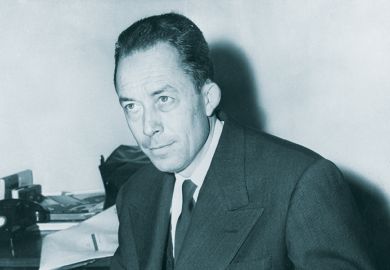Penguin deserves an ovation for its Bard set, says Elisabeth Dutton
- All's Well That Ends Well 184pp, £6.99 ISBN 0 14 101660 4
- Antony and Cleopatra 239pp, £6.99 ISBN 0 14 101228 5
- As You Like It 153pp, £6.99 ISBN 0 14 1012 7
- Cymbeline 310pp, £7.99 ISBN 0 14 070742 5
- Hamlet 320pp, £6.99 ISBN 0 14 101307 9
- Henry IV Part I 205pp, £6.99 ISBN 0 14 101366 4
- Henry IV Part II 264pp, £6.99 ISBN 0 14 101670 1
- Henry VI Part II 260pp, £7.99 ISBN 0 14 101710 4
- Julius Caesar 200pp, £6.99 ISBN 0 14 101239 0
- King Lear 9pp, £6.99 ISBN 0 14 101229 3
- Macbeth 153pp, £6.99 ISBN 0 14 101369 9
- The Merchant of Venice 148pp, £6.99 ISBN 0 14 101395 8
- A Midsummer Night's Dream 129pp, £6.99 ISBN 0 14 101260 9
- Much Ado About Nothing 137pp, £6.99 ISBN 0 14 101230 7
- Othello 191pp, £6.99 ISBN 0 14 101231 5
- Richard III 206pp, £6.99 ISBN 0 14 101303 6
- Romeo and Juliet 242pp, £6.99 ISBN 0 14 101226 9
- Timon of Athens 223pp, £7.99 ISBN 0 14 101661 2
- Twelfth Night 156pp, £6.99 ISBN 0 14 101470 9
- The Winter's Tale 192pp, £6.99 ISBN 0 14 101389 3
"Of making many books there is no end, and much study is a weariness of the flesh." The new Penguin Shakespeare is eager to alleviate the weariness of much study by making quite a few more books. Every three minutes of last year, someone somewhere in the world bought a Penguin Shakespeare - it would seem that, despite stiff competition from proliferating editions of the Bard, Penguin still holds its own.
Nonetheless, the series is being overhauled for a "glittering relaunch"; 20 fully revised, new-look titles have now appeared, and more are promised in October.
The professed aims of the overhaul are a mixture of the soberly conservative and the excitedly ambitious: the series is to be "authoritative" but also "accessible", to "build on the series' existing strengths", but to do this by including "the most up-to-date critical interpretations", all the while "bringing Shakespeare to life for a new generation". The target readership is broad - general readers, students, theatre-goers and actors - and indeed the series does seem broadly on target.
Size isn't everything, but it is something - particularly for the actor.
The new Penguin Shakespeares will fit in the actor's pocket (or in the theatre-goer's handbag) and are "used and recommended by the National Theatre", as the original Penguin Shakespeares were by the Royal Shakespeare Company. The format is exceptionally clear, even in lengthy prose passages that in some editions can lose the reader; blank verse lines are well fitted to the page. (Where a verse line is shared between characters, this is immediately visible in the formatting, which is important for actors because by such lines Shakespeare gives performance clues to the cast.) The text of the play is presented without the interruption of footnotes.
Although footnotes might clutter the page for the actor, notes of some sort are helpful - sometimes vital - for general readers, students and actors alike. The new Penguin Shakespeares provide extensive endnotes that guide interpretation in a number of ways. Significant images or phrases, particularly those that are echoed within a play or elsewhere in Shakespeare's canon, are noted and discussed. Unfamiliar words and phrases are glossed. Sources are indicated, as are contested textual emendations.
Although the endnote format is perhaps less convenient for the student than the footnote favoured by the Arden Shakespeare or the facing-page commentary notes of the Everyman Shakespeare, there is no lack of helpful information.
This series tries to do several things at once and, impressively, often manages it. While the full endnotes are more than adequate for A-level students, a separate "Account of the text" in each volume provides detailed information on editing and textual variation such as an undergraduate might require. Particularly helpful is a separate listing and discussion of stage directions, specifying quarto and folio variants where relevant and indicating where stage directions have been added by modern editors. A "Further reading" section provides annotated bibliography on such matters as sources and performance history. Inevitably, the "Account of the text" and the annotated bibliography occasionally repeat material that is contained in endnotes and introductory essays, but this is a small price to pay for the convenient arrangement of information: a variety of readers can easily select material appropriate to their particular purposes in reading.
The series editor, Stanley Wells, supplies a "General introduction" that summarises what is known of Shakespeare's biography and the development of his reputation through the centuries, and contextualises him with notes on the playhouses of his day. This general introduction is reprinted without adaptation in each volume, but it begins with the assertion that "every play by Shakespeare is unique".
Accordingly, each individual play is given a full introduction by a different Shakespearean scholar. In most cases, this is not the same scholar who is responsible for editing and notes: thus introduction and commentary can provide differing but complementary perspectives on each text. This introductory essay will, of course, provide the most obvious difference in content between each Penguin play and its rival editions: Penguin and Wells have chosen their contributors superbly. Leading scholars such as Katherine Duncan-Jones, Kiernan Ryan and Peter Holland have submitted essays remarkable for their combination of breadth, concision and clarity. Introductory material is indeed "accessible" and "authoritative", maintaining the series' usefulness for general and academic readers.
Because of the noted "unique" nature of each of Shakespeare's plays, the ideal introduction to one play might have a rather different format and focus from that of another. Introductions for the new Penguin Shakespeares vary in focus, length and structure. Some are arranged under headings, which may be concerned with theme (in Hamlet , for example, "Delay and revenge", "The individual and the state", "Patriarchy and madness") or with structural or generic approaches (in Antony and Cleopatra , "From biographical history to fiction", "Dying into life", "Tragedy as sublime comedy"). Instructive comment on genre is woven in one way or another into all the introductions: for all their variety of approach, all the essays also offer vital introductory comment on language, imagery, structure, source adaptation and historical context.
Penguin's press release draws attention to a very welcome new feature of each volume: a new article on the play in performance on stage and screen, "acknowledging the effect of film and stage on the enduring cultural significance of Shakespeare". It might seem that, where a play script is concerned, performance would be more fundamental than an "effect" to be "acknowledged", and the best of the editions give "The play in performance" full treatment. Alan Sinfield's introduction to Hamlet is wonderfully supplemented by actor Paul Prescott's analysis of the play's theatricality, the challenges it presents to actors, the ways in which directors have adapted the text by cutting and pasting scenes.
"Performance" on film as well as on stage is discussed, and it makes the series more useful to the "new generation" for whom Laurence Olivier and Peggy Ashcroft are not even memories, but for whom classic performances and iconic moments may be accessible in recording. Furthermore, discussion suggests that film may be not just a pale shadow of a stage performance, but may in some cases open up new possibilities: René Weis notes that Antony and Cleopatra has recently fared rather better on film than on stage, and that in Trevor Nunn's television production "camera angles, close-ups and blurring of the lens when filming Egypt to convey a sense of its elusiveness pay tribute rather more effectively perhaps than theatrical production can to the melting world of Shakespeare's script".
Each volume is equipped with the general editor's chronology of Shakespeare's writings, which helpfully includes the poems alongside the plays and notes where authorship is collaborative. The differing nature of collaboration is economically indicated by subtle distinctions of phrasing - Pericles is " with George Wilkins", Macbeth is " revised by Middleton", Henry VIII is "by Shakespeare and Fletcher" (emphases mine). By such fine distinctions, the student may be reminded that Shakespeare was not, as he may sometimes appear, a lone star, but the greatest of a group of contemporaries who influenced and sometimes worked with each other.
The listing of Sir Thomas More points the reader to an extant play to which Shakespeare made a small but significant contribution; furthermore, the mention of Cardenio reminds the reader that the canon has not survived complete. Edward III , its authorship uncertain, and Sir Thomas More are the only extant plays that will be omitted from the new Penguin series.
Cymbeline , which mysteriously was not featured in the old series, makes a welcome appearance in the new - welcome not only because it is a much better play than has often been recognised, but also because John Pitcher's introductory essay is truly outstanding. Considering the play theatrically, linguistically and psychoanalytically, historicising its composition with observations from art, literature and science, tracing its varied reception through the ages, Pitcher weaves a virtuoso defence of one of Shakespeare's most mature works.
"That book in many's eyes doth share the glory, that in gold clasps locks in the golden story." Lady Capulet is advising Juliet on her choice of husband, not her holiday reading; we, of course, would know better than to choose a book by its cover. But Penguin has attached some importance to its new Shakespeare covers, as indicated by its recent display at the National Theatre of Clare Melinsky's designs. In contrast to the Arden Shakespeare, the cover illustrations of which seem sometimes wilfully obscure (it is Twelfth Night , not A Midsummer Night's Dream , on which we see an ass-head), Melinsky has illustrated the most iconic symbol, most familiar character or most dramatic moment on the jacket of each play. As Melinsky herself notes, she has followed this principle even where the iconic "moment" is offstage - in the case of Richard III , the murder of the princes in the tower.
Melinsky's artwork is exquisite, combining the traditional style of the woodcut with freshness of colour.
The covers do indeed "evoke the drama of the story inside the book itself" - "story" and "book" rather than "script" and "play" here, because Penguin, intriguingly, presents its Shakespeare relaunch as marking its "dedication to publishing good stories". It may well be true that Shakespeare's plays have remained relevant because of "the stories... and the way he tells them".
It is perhaps less true that simply using the name William Shakespeare on the front cover "in the same way as any other author" will have the desired effect of "bringing Shakespeare the man and author into a more familiar relationship with the reader" (particularly when the covers also bear cringe-worthy recommendations such as Olivier's "Shakespeare - the nearest thing in incarnation to the eye of God"). Penguin's decision does, however, draw attention to the startling absence of the playwright's name from the jackets of most other editions. Its new covers refreshingly admit that it is Shakespeare, not the publisher, who sells - and since Shakespeare study is far from wearying, there will be no end to the making of his books.
Elisabeth Dutton is lecturer in medieval English, Magdalen College, Oxford.
The Penguin Shakespeare Series
Editor - General editor: Stanley Wells
Register to continue
Why register?
- Registration is free and only takes a moment
- Once registered, you can read 3 articles a month
- Sign up for our newsletter
Subscribe
Or subscribe for unlimited access to:
- Unlimited access to news, views, insights & reviews
- Digital editions
- Digital access to THE’s university and college rankings analysis
Already registered or a current subscriber? Login



